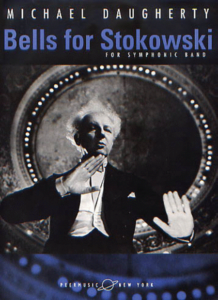Bells for Stokowski
for symphonic band (2002)
Instrumentation: Piccolo, 3 flutes, 2 oboes, English horn, 5 clarinets, 2 bassoons, contrabassoon; soprano sax, alto sax, tenor sax, baritone sax; 4 horns, 4 trumpets, 3 trombones, 2 baritones, tuba; 2 contrabassi; timpani, 4 percussion; guitar, 2 harps, organ
Publisher:
Peermusic Classical, BMI (Americas and Asia)
Faber Music (Europe, Australia and New Zealand)
Duration: 13:30 minutes
World Premiere: February 2003 / National Conference of the College Band Directors National Association, Minneapolis, Minnesota / Arizona State University Wind Ensemble

Program Note:
Bells for Stokowski (2002) for symphonic band was commissioned by a consortium including the University of Michigan (Michael Haithcock), Arizona State University (Gary Hill), Baylor University (Kevin Sedatole), University of Colorado (Allan McMurray), Ithaca College (Steve Peterson), Louisiana State University (Frank Wickes), Michigan State University (John Whitwell), Riverside, CA Community College (Kevin Mayse),University of Tennessee (Gary Sousa), University of Texas (Jerry Junkin), and Texas Tech University (John Cody Birdwell). Its first performance was given by the University of Michigan Symphony Band, conducted by Michael Haithcock, in the Michigan Theater, Ann Arbor, Michigan, on October 2, 2002. It was performed by the Arizona State University Wind Ensemble, conducted by Gary Hill, at the National Conference of the College Band Directors National Association, Minneapolis, Minnesota, on March 27, 2003.
Bells for Stokowski is a tribute to one of the most influential and controversial conductors of the 20th century. Born in London, Leopold Stokowski (1882-1977) began his career as an organist. As maestro of the Philadelphia Orchestra (1912-36), he became famous for interpreting classical music in brilliant new ways, and expanding his audience’s expectations of what might they hear in the concert hall. In Philadelphia, Stokowski boldly conducted American music alongside European traditional and new orchestral repertoire. Stokowski created a sensation by conducting world premieres of avant-garde composers such as Igor Stravinsky and Edgar Varese, and he enraged classical purists with his lavishly Romantic orchestral transcriptions of Bach. Appearing as a conductor in various Hollywood films, Stokowski’s 1940 collaboration with Walt Disney in Fantasia resulted in the first stereophonic recording of an orchestral soundtrack. It was in Philadelphia that he created the famous “Stokowski sound,” making the orchestra sound like a pipe organ. His fascination with timbre led him to experiment with the seating of players, moving sections of the orchestra to different parts of the stage. These dramatic spatial arrangements appealed to the eye as well as the ear.
In Bells for Stokowski I imagine Stokowski in Philadelphia visiting the Liberty Bell at sunrise, and listening to all the bells of the city resonate. The composition begins with two percussionists, placed on opposite ends of the stage, performing stereophonically on identical ringing percussion instruments such as chimes, crotales, sleigh bells, bell trees, and various non-pitched metals. A saxophone quartet introduces an original theme that I have composed in the style of Bach. This baroque fantasy is modulated in my musical language through a series of tonal and atonal variations. Later in this composition I also introduce my own “transcription” of Bach’s C Major Prelude from The Well-Tempered Klavier.
In keeping with Stokowski’s musical vision, I look simultaneously to the past and the future of American concert music. I utilize multiple musical canons, polyrhythms, and counterpoints to achieve a complex timbral layering throughout Bells for Stokowski. With unusual orchestrations and an alternation between chamber and tutti configurations, I recreate the musical effect of Stokowski’s experimental seating rearrangements. In the coda I evoke the famous “Stokowski sound,” by making the symphonic band resound like an enormous, rumbling Gothic organ.
–Michael Daugherty
